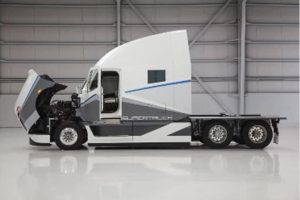Daimler’s SuperTruck receives 115% efficiency improvement
Have you seen the latest SuperTruck update? If you missed the 2015 Mid-America Trucking Show that just concluded in Louisville, KY, you missed Daimler’s unveiling of their newest incarnation of the SuperTruck.
They’re pretty excited about this vehicle, in large part because instead of merely reaching the government’s goal of a 50% improvement in freight fuel efficiency, this truck has achieved a 115% improvement. In something of an understatement, Diane Hames, general manager of marketing and strategy for Daimler Trucks North America, said “This has been a very fruitful use of taxpayer dollars…hats off to our engineers.”
No kidding.
Her reference to taxpayer dollars reminds us that the SuperTruck program is a joint effort of the US Department of Energy and Daimler and other heavy duty truck manufacturers. The program was established to speed up research and testing that would lead to a far more fuel-efficient over-the-road truck. The program is working well.
How did DTNA reach this amazing goal?
It wasn’t easy, says Derek Rotz, DTNA’s Principal SuperTruck Investigator, because there were conflicting goals. “Cooling the engine and improving aerodynamic performance are typically at odds with each other in terms of how they handle the air flow,” he explains. “Aerodynamics want to keep the air external to the vehicle, and cooling requires air to go within the engine compartment.”
 The solution? An articulating grill that opens at lower speeds to cool the engine and then closes at higher speeds with aerodynamics matter most.
The solution? An articulating grill that opens at lower speeds to cool the engine and then closes at higher speeds with aerodynamics matter most.
Daimler’s engineers performed a series of tests to confirm their results. They ran the vehicle on highway routes in Texas and Oregon plus a city route in Portland, OR. They also conducted anti-idle testing in both a hot chamber and cold chamber. Compared to a 2009 baseline truck, tests shows a combined 115% freight efficiency improvement. They also conducted tests at the DTNA Detroit engineering facility, with results showing 50.2% engine brake thermal efficiency.
Finally, Daimler’s SuperTruck made a five-day, 312-mile round trip between Dallas and San Antonio on Interstate 35. Weighing 65,000 lbs. GVWR and traveling at a speed of 65 mph, the truck averaged 12.2 mpg.
As part of the process, engineers also studied other technologies, including electrified auxiliaries, controlled power steering and air systems, a long-haul hybrid system, waste heat recovery, trailer solar panels and active aerodynamics. Although these may prove valuable in the future, engineers concluded that so far regulatory or economic barriers make them not viable for commercial use.
Not all SuperTruck components are brand new.
Not to ignore existing components that have already proven themselves in the efficiency and productivity departments, DTNA’s SuperTruck also includes these features:
- 6×2 optimization.
- Aerodynamic components from the Freightliner Cascadia Evolution
- Integrated Detroit Powertrain
- Downspeeding with a custom engine rating
Intelligent Powertrain Management technology that offers predictive capabilities, thanks to pre-loaded 3D digital maps that control shifting and eCoast events.
